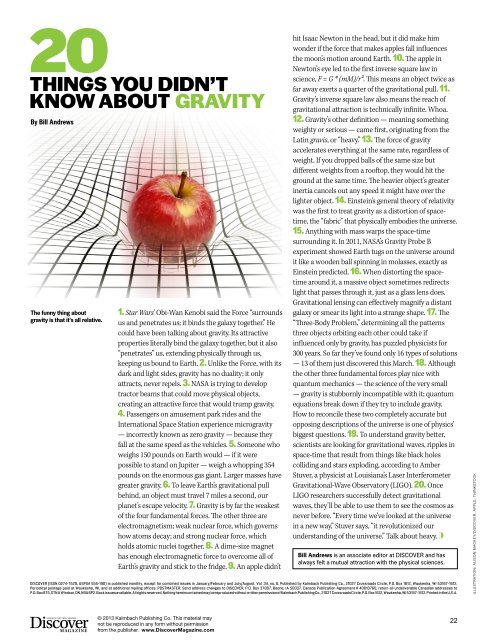GRAVITATIONAL WAVES
DIG-ASY-PRM_GravWavesFIN
DIG-ASY-PRM_GravWavesFIN
You also want an ePaper? Increase the reach of your titles
YUMPU automatically turns print PDFs into web optimized ePapers that Google loves.
20<br />
THINGS YOU DIDN’T<br />
KNOW ABOUT GRAVITY<br />
By Bill Andrews<br />
The funny thing about<br />
gravity is that it's all relative.<br />
1. Star Wars' Obi-Wan Kenobi said the Force “surrounds<br />
us and penetrates us; it binds the galaxy together.” He<br />
could have been talking about gravity. Its attractive<br />
properties literally bind the galaxy together, but it also<br />
“penetrates” us, extending physically through us,<br />
keeping us bound to Earth. 2. Unlike the Force, with its<br />
dark and light sides, gravity has no duality; it only<br />
attracts, never repels. 3. NASA is trying to develop<br />
tractor beams that could move physical objects,<br />
creating an attractive force that would trump gravity.<br />
4. Passengers on amusement park rides and the<br />
International Space Station experience microgravity<br />
— incorrectly known as zero gravity — because they<br />
fall at the same speed as the vehicles. 5. Someone who<br />
weighs 150 pounds on Earth would — if it were<br />
possible to stand on Jupiter — weigh a whopping 354<br />
pounds on the enormous gas giant. Larger masses have<br />
greater gravity. 6. To leave Earth’s gravitational pull<br />
behind, an object must travel 7 miles a second, our<br />
planet’s escape velocity. 7. Gravity is by far the weakest<br />
of the four fundamental forces. The other three are<br />
electromagnetism; weak nuclear force, which governs<br />
how atoms decay; and strong nuclear force, which<br />
holds atomic nuclei together. 8. A dime-size magnet<br />
has enough electromagnetic force to overcome all of<br />
Earth’s gravity and stick to the fridge. 9. An apple didn't<br />
hit Isaac Newton in the head, but it did make him<br />
wonder if the force that makes apples fall influences<br />
the moon’s motion around Earth. 10. The apple in<br />
Newton’s eye led to the first inverse square law in<br />
science, F = G * (mM)/r2. This means an object twice as<br />
far away exerts a quarter of the gravitational pull. 11.<br />
Gravity’s inverse square law also means the reach of<br />
gravitational attraction is technically infinite. Whoa.<br />
12. Gravity’s other definition — meaning something<br />
weighty or serious — came first, originating from the<br />
Latin gravis, or “heavy.” 13. The force of gravity<br />
accelerates everything at the same rate, regardless of<br />
weight. If you dropped balls of the same size but<br />
different weights from a rooftop, they would hit the<br />
ground at the same time. The heavier object’s greater<br />
inertia cancels out any speed it might have over the<br />
lighter object. 14. Einstein’s general theory of relativity<br />
was the first to treat gravity as a distortion of spacetime,<br />
the “fabric” that physically embodies the universe.<br />
15. Anything with mass warps the space-time<br />
surrounding it. In 2011, NASA’s Gravity Probe B<br />
experiment showed Earth tugs on the universe around<br />
it like a wooden ball spinning in molasses, exactly as<br />
Einstein predicted. 16. When distorting the spacetime<br />
around it, a massive object sometimes redirects<br />
light that passes through it, just as a glass lens does.<br />
Gravitational lensing can effectively magnify a distant<br />
galaxy or smear its light into a strange shape. 17. The<br />
“Three-Body Problem,” determining all the patterns<br />
three objects orbiting each other could take if<br />
influenced only by gravity, has puzzled physicists for<br />
300 years. So far they’ve found only 16 types of solutions<br />
— 13 of them just discovered this March. 18. Although<br />
the other three fundamental forces play nice with<br />
quantum mechanics — the science of the very small<br />
— gravity is stubbornly incompatible with it; quantum<br />
equations break down if they try to include gravity.<br />
How to reconcile these two completely accurate but<br />
opposing descriptions of the universe is one of physics’<br />
biggest questions. 19. To understand gravity better,<br />
scientists are looking for gravitational waves, ripples in<br />
space-time that result from things like black holes<br />
colliding and stars exploding, according to Amber<br />
Stuver, a physicist at Louisiana’s Laser Interferometer<br />
Gravitational-Wave Observatory (LIGO). 20. Once<br />
LIGO researchers successfully detect gravitational<br />
waves, they’ll be able to use them to see the cosmos as<br />
never before. “Every time we’ve looked at the universe<br />
in a new way,” Stuver says, “it revolutionized our<br />
understanding of the universe.” Talk about heavy.<br />
Bill Andrews is an associate editor at DISCOVER and has<br />
always felt a mutual attraction with the physical sciences.<br />
DISCOVER (ISSN 0274-7529, USPS# 555-190) is published monthly, except for combined issues in January/February and July/August. Vol. 34, no. 6. Published by Kalmbach Publishing Co., 21027 Crossroads Circle, P.O. Box 1612, Waukesha, WI 53187-1612.<br />
Periodical postage paid at Waukesha, WI, and at additional mailing offices. POSTMASTER: Send address changes to DISCOVER, P.O. Box 37807, Boone, IA 50037. Canada Publication Agreement # 40010760, return all undeliverable Canadian addresses to<br />
P.O. Box 875, STN A Windsor, ON, N9A 6P2. Back issues available. All rights reserved. Nothing herein contained may be reproduced without written permission of Kalmbach Publishing Co., 21027 Crossroads Circle, P.O. Box 1612, Waukesha, WI 53187-1612. Printed in the U.S.A.<br />
ILLUSTRATION: ALISON MACKEY/DISCOVER. APPLE: THINKSTOCK<br />
© 2013 Kalmbach Publishing Co. This material may<br />
not be reproduced in any form without permission<br />
from the publisher. www.DiscoverMagazine.com<br />
22


